Do you need to quickly get system information about your WordPress site?
System information tells you about your hosting environment, PHP version, WordPress settings, and more. You will often need to share this information when asking for support because it can help with troubleshooting WordPress issues.
In this guide, we will show you how to easily get system information for your WordPress site without any special technical skills.

What Is System Information for a WordPress Site?
WordPress needs a specific platform to run. This platform is provided by your WordPress hosting company.
It is made of several components, including web server software (Apache or NGINX), PHP (a programming language), database software (MySQL), and more.
All of these software elements have different features that your WordPress hosting company configures and sets up for you. For more on this topic, please see our guide on how WordPress works behind the scenes.
Apart from that, you also have your own WordPress settings. For instance, there will be different settings depending on which WordPress plugins or theme you are using and how your WordPress website is set up.
Together, all this information is called System Information. You can use this information to fix common WordPress errors and troubleshoot other website issues.
You may also be asked by other developers on support forums to share system information. This helps them quickly see if a particular feature is available on your hosting.
That being said, let’s take a look at how to easily access system information for your WordPress website without any technical skills.
Getting WordPress System Information Using The Site Health Page
WordPress comes with a built-in tool called Site Health that helps you quickly access system information about your website.
You can access it by logging in to your WordPress admin area and visiting the Tools » Site Health page.
Here, WordPress will show a Site Health Status report and highlight any critical issues that need your attention. For more details, please see our guide on how to get the perfect WordPress site health score.
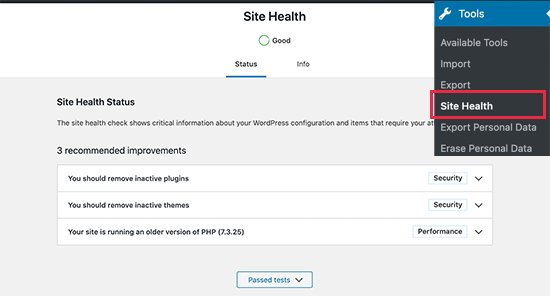
To get system information, you need to switch to the ‘Info’ tab on the Site Health page.
From here, you will see important system information neatly organized into categories.
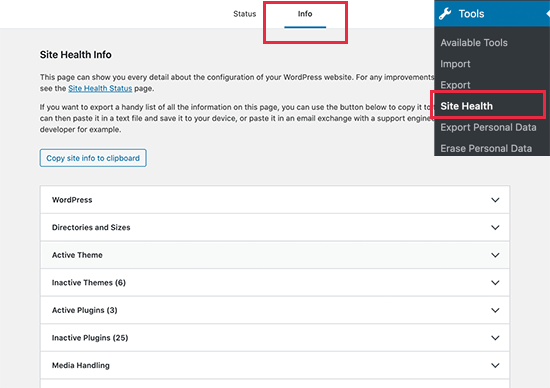
You can click on the ‘Copy to Clipboard’ button to copy all of the information. After that, you can just paste this information anywhere you need to share it.
Ideally, you would also want to save it to your computer in a plain text file using Notepad or any plain text editor app.
If you are looking for specific information, then you can expand the related category and copy that information alone.
You can expand and see the following site information:
- WordPress installation
- Directories and sizes
- Active and inactive themes
- Active and inactive plugins
- Media handling
- Server configuration
- WordPress database
- WordPress constants
- Filesystem permissions
For instance, if you were looking for which PHP version your WordPress hosting server is using, then you will find this information under the ‘Server’ section.
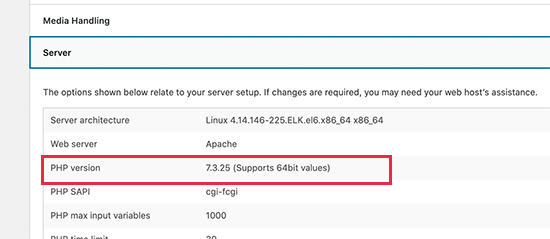
Similarly, if you want to check the file size upload limit, then you will find this information under the ‘Media Handling’ section.
The Site Health tool makes it easier to get all the system information you need in a neat and more readable format.
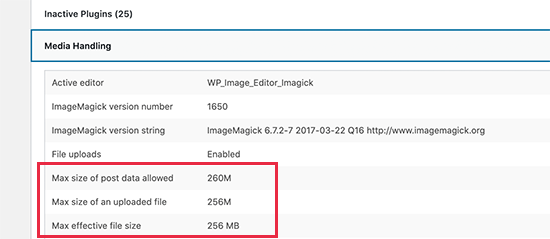
However, there may still be other system information that you can’t find in this report. In that case, this next step will give more comprehensive system information for your site.
Getting System Information in WordPress Using a Plugin
The default Site Health tool in WordPress gives you all the essential information needed for troubleshooting. However, sometimes, you may need additional information about PHP configuration on your server.
The easiest way to get this information is by using a WordPress plugin that shows complete PHP information.
First, you need to install and activate the Debug Info plugin. For more details, see our step-by-step guide on how to install a WordPress plugin.
Upon activation, you need to visit the Tools » Debug Info page in your WordPress dashboard.
From here, you will first see an overview of system information similar to the Site Health tool. It also acts as a WordPress theme detector, so you will see your current WordPress theme version, author, and URI.
Scroll down to the bottom and then click on the ‘Show Details’ link.
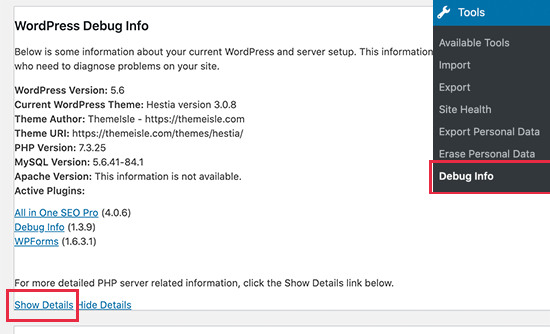
This will show the PHP info page.
It provides complete information about which PHP features are enabled on your hosting server.
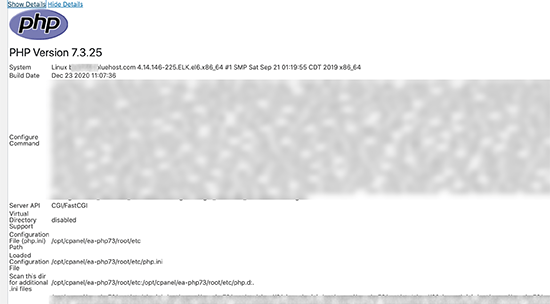
If you know the specific information that you are looking for, then you can look for it here. Alternatively, you can also copy and paste this information and share it with developers or on a support ticket.
We hope this information helped you quickly get system information for your WordPress site. You may also want to see our article on how to tighten WordPress security to protect your website against hacking and our guide to the best managed WordPress hosting providers.
If you liked this article, then please subscribe to our YouTube Channel for WordPress video tutorials. You can also find us on Twitter and Facebook.





Syed Balkhi says
Hey WPBeginner readers,
Did you know you can win exciting prizes by commenting on WPBeginner?
Every month, our top blog commenters will win HUGE rewards, including premium WordPress plugin licenses and cash prizes.
You can get more details about the contest from here.
Start sharing your thoughts below to stand a chance to win!
June Nacpil says
Hello WP Beginner team,
seems like the recommended plugin is now unavailable for download.
WPBeginner Support says
Thank you for letting us know, we’ll be sure to look for an alternative we would recommend
Admin
Stryker Graham says
Thanks! That was SUPER easy… You presented all the most relevant info in the first 45 seconds!
Keith Lockhart says
Syed,
Have a look at this plugin: http://Wordpress.org/plugins/bns-support. It lists some other useful site things in the sidebar.
Keith – Gr8WhiteNorth